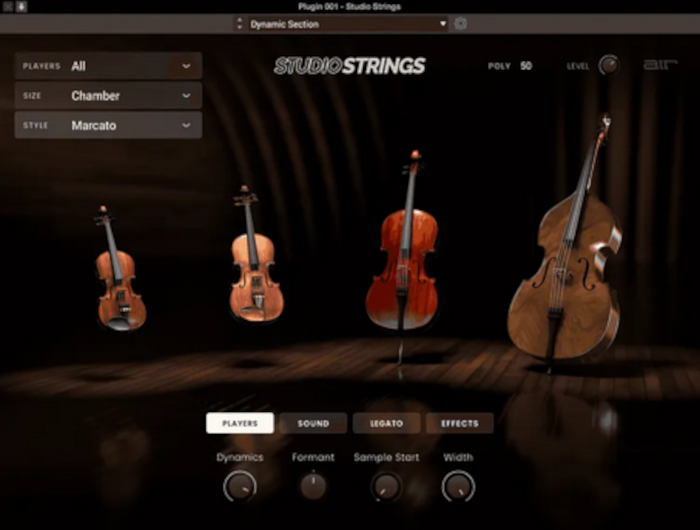Whether you’re looking to add lush string textures to your electronic productions or aiming to score a full orchestra, AIR’s Studio Strings virtual instrument plug-in is an invaluable tool for any composer or producer. Offering four essential string models — bass, cello, viola, and violin — this virtual instrument is designed for seamless integration into your DAW environment. With nine unique articulations for each instrument, you can inject a human touch into your compositions, ensuring your string sections feel alive and dynamic. Studio Strings also includes an onboard effects suite with delay, EQ, reverb, and other essential tools, allowing you to tailor the sound for various projects, from lifelike orchestral scores to ambient soundscapes.
The versatility of AIR’s Studio Strings virtual instrument makes it suitable for a wide range of musical genres and production needs. Whether you’re creating a cinematic score or enhancing a pop track with orchestral elements, the ability to manipulate each instrument individually ensures that you have complete control over the sound. Each string model comes equipped with a variety of articulations, such as Marcato, Sustain, Staccato, and more, enabling you to replicate the natural dynamics of a live string performance. This attention to detail ensures that the virtual instrument not only sounds realistic but also performs with the nuances and expressiveness of a live orchestra.
Comprehensive String Models for Ultimate Control
The Studio Strings virtual instrument offers four meticulously recorded string models: violin, viola, cello, and bass. Each model provides an authentic representation of its real-world counterpart, delivering the depth and warmth you’d expect from a symphonic string section. Whether you need the high-pitched vibrancy of the violin or the deep, resonant tones of the bass, this virtual instrument has you covered. By including all four string sections, AIR’s Studio Strings gives you the flexibility to craft anything from solo string arrangements to full orchestral compositions, ensuring your project has the appropriate sound.
Additionally, the wide array of articulations available for each instrument allows for precise control over the performance. Whether you’re looking for the sustained power of legato or the sharp attack of pizzicato, Studio Strings provides the necessary tools to replicate the emotion and intricacy of a real string ensemble. This makes the virtual instrument ideal not just for classical compositions but also for modern productions where string elements add emotional depth and texture.
Built-in Effects for Versatile Sound Design
One of the standout features of the Studio Strings virtual instrument is its comprehensive onboard effects suite. This suite includes essential effects such as delay, EQ, and reverb, enabling you to fine-tune the sound of your strings to fit the needs of your project. Whether you’re aiming for a spacious, reverb-drenched orchestral sound or a tighter, more intimate string arrangement, the effects provided in Studio Strings give you the flexibility to sculpt the perfect sonic landscape.
The addition of these effects ensures that you can use Studio Strings not only for traditional symphonic compositions but also for experimental and genre-blending projects. Whether you’re working on a film score, a pop track, or an ambient piece, the built-in effects offer endless sonic possibilities, allowing you to push the boundaries of what a virtual instrument can achieve.
Integration with Akai Professional MPC and FORCE
For those who work with hardware in addition to software, Studio Strings offers compatibility with Akai Professional’s MPC and FORCE devices. This integration allows users to take their string arrangements directly into hardware workflows, bridging the gap between in-the-box production and hands-on hardware control. Whether you prefer working entirely within your DAW or integrating hardware into your production setup, Studio Strings provides the flexibility to adapt to your workflow. This makes it a versatile choice for both studio-based producers and live performers who want the tactile control of hardware.
Instant Usability with Over 1GB of Content
The Studio Strings virtual instrument comes with over 1GB of high-quality content, including 100 onboard presets for instant creativity. These presets are designed to provide inspiration right out of the box, allowing you to quickly find the perfect sound for your project. Whether you’re looking for a lush string pad or a sharp staccato line, the included presets offer a wide variety of sonic textures to choose from. This level of instant usability makes Studio Strings a valuable tool for composers who need to work quickly without sacrificing sound quality.
Key Features of AIR’s Studio Strings Virtual Instrument Plug-in:
- A symphonic string virtual instrument created from dozens of meticulously recorded samples.
- Includes four distinct string models: violin, viola, cello, and bass, each with unique articulations for realistic sound dynamics.
- Provides Marcato, Sustain, Staccato, and more, ensuring that each instrument can perform a wide range of articulations for an authentic performance.
- Over 1GB of content and 100 presets, offering instant inspiration and ease of use.
- Built-in effects suite with delay, EQ, reverb, and more for creating expansive and versatile sonic landscapes.
- Compatible with both Windows and macOS workstations, making it suitable for a variety of setups and workflows.
In conclusion, AIR’s Studio Strings virtual instrument is an indispensable tool for any producer or composer looking to add high-quality string elements to their productions. Its combination of realistic string models, versatile articulations, and built-in effects makes it a powerful and flexible option for any project. Whether you’re scoring a film or creating a modern electronic track, Studio Strings offers the tools you need to bring your compositions to life.


0 Comments